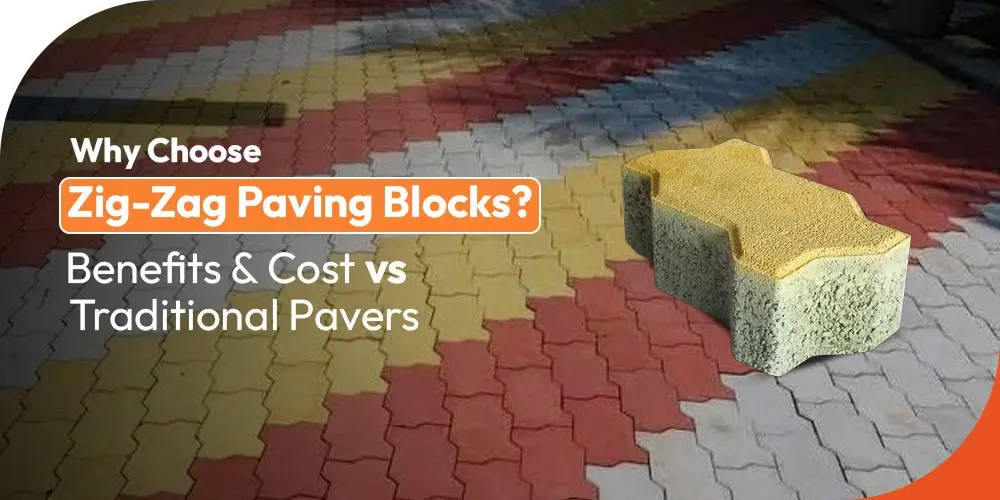When it comes to hardscaping, driveways, walkways, parking zones, or commercial outdoor flooring, long-term performance should matter more than just upfront cost. And that’s exactly where zig-zag paving blocks consistently outperform traditional pavers. Their geometry, load distribution, and lifecycle economics make them a strategic choice for projects that demand durability and low maintenance.
This guide breaks down the practical value of zig-zag pavers in a real-world, decision-maker-friendly manner.
What Exactly Are Zig Zag Paving Blocks?
Zig-zag pavers are interlocking concrete blocks shaped to form a “Z” or “S” pattern when placed together. Unlike plain rectangular slabs or poured concrete, these blocks lock mechanically, creating a stronger, more stable surface.
Their structure makes them a preferred option in high-traffic areas, municipal spaces, industrial yards, and residential outdoor zones.
Key Benefits of Zig Zag Paving Blocks
1. Superior Load-Bearing & Structural Strength
The biggest advantage of zig-zag blocks is how they distribute weight.
The interlocking pattern spreads vehicular and foot traffic loads evenly across the surface, reducing the risk of cracks, breaks, and settlement.
This makes them suitable for:
- Heavy-vehicle driveways
- Parking lots
- Industrial access areas
- Municipal paving projects
Traditional pavers don’t have this mechanical lock, so stress concentrates on specific points, leading to cracks over time.
2. Long-Term Durability in Harsh Conditions
Zig-zag pavers are engineered to withstand:
- Continuous vehicle movement
- Seasonal temperature shifts
- Moisture exposure
- Wear from sand, mud, and surface friction
Unlike monolithic concrete slabs, they don’t crack in large patches when the base shifts slightly. Their modular nature absorbs minor movement without structural failure.
3. Easy Maintenance & Low Repair Cost
One of the strongest business cases for zig-zag pavers is maintenance efficiency.
If one unit gets damaged, you replace only that block, not the entire stretch. This reduces downtime and keeps long-term repair expenses under control.
Traditional paving methods often require patching, resurfacing, or full slab replacement, which compounds cost and disruption.
4. Reliable Drainage & Surface Stability
Because the layout includes narrow joints, zig-zag pavers naturally allow controlled water flow. This helps prevent:
- Waterlogging
- Slippery surfaces
- Erosion under the slab
- Surface heaving
The stable interlock also keeps the blocks from shifting or separating under pressure, creating a consistently even surface that improves safety.
5. Design Flexibility Without Operational Trade-Offs
Zig-zag pavers offer practical variety:
- Multiple colours
- Modular patterns
- Suitable for residential and commercial environments
You get both aesthetics and performance, a combination traditional concrete rarely achieves without premium treatment or custom design.
Cost Comparison: Zig Zag Pavers vs Traditional Pavers
Let’s look at value from a practical, lifecycle standpoint.
1. Upfront Cost
- Zig-zag pavers: Slightly higher due to precision manufacturing and interlocking shape
- Traditional slabs/poured concrete: Lower per-square-foot initial cost
However, upfront numbers don’t tell the whole story.
2. Installation
Zig-zag pavers require:
- Proper base preparation
- Bedding layer
- Skilled interlocking placement
Traditional surfaces, especially poured concrete, may seem easier to install, but often fail early if the base isn’t engineered perfectly.
3. Maintenance Over Time
| Factor | Zig Zag Pavers | Traditional Pavers |
|---|---|---|
| Crack risk | Low due to interlock | High, especially under heavy load |
| Replacement | Replace single block | Large patches or sections |
| Long-term repair cost | Low | Medium to high |
| Downtime during repairs | Minimal | Often significant |
The modularity of zig-zag blocks makes them far more cost-efficient over a 10-20 year period.
4. Total Cost of Ownership (TCO)
When decision-makers evaluate flooring solutions, the smart metric isn’t upfront price, but lifecycle economics.
Zig-zag pavers generally deliver a lower TCO due to:
- Better structural longevity
- Fewer failures
- Minor, localised repairs
- Stronger performance under traffic
Traditional paving might look economical at installation, but it usually ends up more expensive to maintain.
When Are Traditional Pavers Still Acceptable?
While zig-zag pavers outperform in most demanding environments, traditional pavers still work well when:
- Foot traffic is low
- Budget is extremely tight
- The installation is temporary
- A very specific aesthetic is required
However, for long-term, high-usage, or commercial settings, zig-zag pavers clearly win on value.
Final Recommendation
If the project involves driveways, parking areas, busy walkways, or any zone expected to handle a consistent load, zig-zag paving blocks offer the strongest blend of durability, maintenance convenience, and lifecycle value.
They may cost slightly more at the start, but they protect the project budget and the surface quality over many years. For professionals who prioritise reliability, safety, and economics, zig-zag pavers are the strategic choice.

